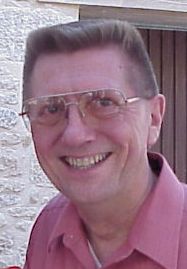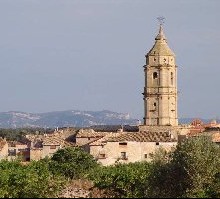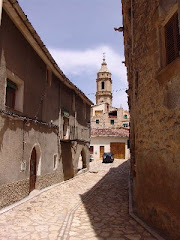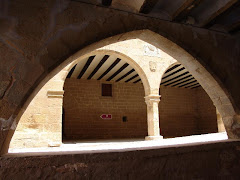Summer came and went. Jordi eventually heard from his cousin in Pamplona that while his grandmother was in the hospital, she got all the way to “Death’s Door,” paused there for a few days and decided not to step over the threshold, turned around and got better. She was back at home in her apartment with her daughter, Adelina, a Nun.
Funeral arrangements were put on-hold. Finally, around the 15 of December, 2006, Jordi’s grandmother died. Jordi was already in to
Jordi was told the relatives didn’t want very much from his grandmother’s apartment and was asked if we could go help his Aunt/Nun pack up the remaining things and take them. His Aunt would not be able to take very much when she returned to the convent.
His aunt, Adelina, had become a Nun at an early age, taught school for 30 years and retired. When her mother – at the age of 90 -- became ill, Adelina took a leave of absence from the convent to take care of her mother until she died and would then return to the convent. Well, her mother remained “ill” for 15 years, before dying at the age of 105 (three and a half months shy of her 106 birthday on 1 April 2007).
Jordi had never made the trip to
We checked the weather report for
We drove the two hours from the village to
One thing about the Spanish, they are not shy about asking for directions. While stopped at a stop light, Jordi rolled down his window and asked the guy in the car next to us which road we should take to go to
As I started to move forward, I asked Jordi where I was supposed to go. He said, “The man said to continue going straight and we would see a sign.” (Jordi always gives me the ABRIDGED version.) So, I continued going straight. We drove for several miles and never saw a sign to
◄- Todos Direccións (All Directions)
We decided to turn around and take our chances with that sign and see where it would lead us.
As luck would have it, after going a few miles and seeing no signs directing us to distant cities, I saw a very small sign on the shoulder of the road indicating we were on the correct interstate – but it didn’t say if we were headed in the correct direction. It wasn’t until much later that we discovered we were heading in the right direction. I’m sure it was purely by accident we happened on this road – but after about 30 minutes of driving around looking for a sign that didn’t exist and ending up on the right road, I was not going to question it. I did tell Jordi that on the way back, we would have to pay close attention and see if we could avoid having to go into Zaragoza’s city center.
But, on the way back, as we approached
So, the trip from our village to Pamplona takes 4-hours – two hours to Zaragoza, then two hours from Zaragoza to Pamplona – plus however much time it takes you to get OUT of Zaragoza and onto the correct interstate.
INFORMATION ABOUT
The walls of
As the years went by, the city grew and eventually needed to expand beyond the walls. In 1915, the walls on the Southern front were torn down. Three quarters of the original perimeter still remains in place.
The first night we were in
To add even more interest to our “moonlight marathon,” we decided to go “Tapa Hopping.” All bars sell tapas (little snacks to eat with whatever you are drinking) and usually have one tapa that is THEIR speciality. Tapa hopping is when you go from bar-to-bar sampling their tapas and washing them down with a drink – in our case a glass of wine. Some people do this because they are hungry and since the restaurants don’t open until 9 or 10pm this is a fun way to eat – after 3 or 4 bars you are full – of both food and drink – and find yourself wondering if your legs will be strong enough to get you home.
After stopping in 3 bars, we made it home safely. Pili then laid out a spread of cheese, crackers, French bread, sausage, mussels, olives, pickles and more wonderful red wine from the
I had no trouble falling asleep that night.
The next day, Saturday, we went to Jordi’s grandmother’s apartment where his Aunt/Nun was and helped her wrap and pack the remaining things – a set of china, flatware, glasses, sewing machine, small kitchen table, some pots and pans, and other things I can’t remember right now. When we loaded up the car, it was packed.
Jordi and his Aunt Adelina, the Nun.
Another picture of Jordi and his Aunt Adelina, the Nun.
Aunt Adelina, the Nun.
Aunt Adelina, the Nun.
Sunday, Pili said she wanted to take us on a tour of the city so I could take some pictures. I didn’t know it was going to be an “All-Day Marathon.” (I know I must be a couple of inches shorter than I was before the walk!) But I have to say, Pili was a great guide and we saw almost everything.
I did take some pictures. I have more, but they are still in the camera.
Only a few blocks from her apartment building (which is almost across the street from the building where Jordi's Grandmother and Aunt lived) is a beautiful, large park.
The park is called
In the park is a nice-sized lake.
Just on the other side of the little shelter that sticks out into the lake is a large hill.
On the lake-side of the hill is a beautiful waterfall.
On the opposite side of the hill is a modern sculpture of St. Francis.
Jordi is standing in the picture with his cousin, Pili.
The walls in
Pamplona can boast about its over 4 million square meters of parks and gardens (approx. 20% of its municipal area). The
The most prestigious military engineers of that time participated in the design of the walls. In 1560, Antonelli convinced Felipe II of the necessity of building a Ciudadela, which was designed to copy the Ciudadela in
Jordi and Pili are waiting for me to hurry and take the picture so we can go in.
In the late 1600s, they decided to reinforce the walls and built a new defense system. In 1720, the inside quarters of the Ciudadela was enlarged.
In 1512, King Fernando the Catholic has a castle built in the center of the city – where the Plaza del Castillo is now.
Not a single stone remains of that first construction.
<><><><><><><><><><><><>
Sanfermin is
Until the early 1920s, the Sanfermines was a fiesta known only to the local people. Ernest Hemingway played a key role in advertising this fiesta with his novel “Fiesta” (“The Sun Also Rises," 1926), along with Henry King’s film starring Ava Gardner, Errol Flynn and Tyrone Power.
Today Sanfermin is 204 hours of Fiesta! It starts at midday on July 6th -- it’s noisy, lively, uninhibited, massively attended and internationally celebrated.
It ends at midnight July 14th to the sound of the song Pobre de mí (Poor old me).
RUNNING THE BULLS
The Encierro (to confine, enclose, contain)
The bulls start the run at the far end of this photo. They will be running toward where I am standing.
Six bulls run and will be fought in the afternoon. A group of 8 bullocks (young castrated bulls) run together with the bulls, guiding them. The bullocks are easily recognized because they have a cowbell around their neck. Three more bullocks are released two minutes later to pick up stray bulls that have separated from the main herd.
Store fronts along the route are either borded up or fences are put in front to keep the bulls and runners from breaking the stores and homes windows.
This stretch is a steep, uphill slope. The bulls tend to cluster together.
This is one of the most dangerous and violent stretches.
In case the bulls get disoriented, there are signs on the buildings showing them which way to go.
The uphill stretch passes the
Almost across the street from the Church is the indoor market place.
Just behind the market place (at the end of the street) is one of the original walls that surrounds the city.
The bulls run past the Ayuntamiento (City Hall) (the building with the flags on it), across the plaza towards me, then turn to the right (facing the Ayuntamiento).
The bulls continue to follow the signs.
At the end of this street, they bulls have to make a 90-degree turn to the right.
The bulls slip and bump into the external fences.
Runners are advised to keep to the right as they make the turn or they will get trapped between the bulls and the fence.
This is the Calle Estafeta turn.
At this corner you have to make the 90-degree turn to the right.
All the bulls have to do is look up and they can see the “No Entry” sign and the sign showing which way to go.
When you make the turn off of Calle Estafeta, you then go up Calle Bajada de Javier.
It has a slight 2% long and narrow uphill slope.
It’s looks wide in this picture, but on the day of the run, it is one of the most crowded stretches.
Runners can only escape in the doorways of the buildings.
Double wooden fences on each side of the street going to the Bull Ring start to narrow, causing a funnel effect into the Plaza de Toros (Bull Ring). (The red door on the left of the picture.)
Running the Bulls Information:
Hour: 8:00am
Date: July 7th to 14th
Route:
Average Duration: 3 min. 55 sec.
Average Speed of Bulls: 24km/h (
Number of Runners: 2,000 on a normal day - 3,500 on weekends
Injured Runners per Year: Between 200 and 300. Only 3% are seriously wounded.
Deaths: 14 (between 1924-2003)
(The Santa Claus of the Basque Country)
On the 24th of December, Olentzero makes his appearance.
The common assumption is that this character was derived from the occupation of a charcoal maker. His image changes from place to place, but he is characteristically dressed in the traditional "baserri" or peasant farmer's garb of dark pants tucked into socks below the knees; "abarkak" or leather, rope-tied shoes; a dark overshirt sometimes with a coat of natural wool; a black beret, staff and a smoking pipe.
In the middle of every winter, at the end of every year, Olentzero goes to all the towns in the Basque Country delivering toys and presents to children who don't have parents and grandparents to give them presents. The children in all the towns celebrate the coming of the Olentzero by singing songs and spreading his message of love, strength and courage.
Some people don't believe that Olentzero really exists. But in Basque there is an old saying: Everything that has a name exists, if we believe it does.
January was unseasonably warm.
People were sitting out in the sun, having a coffee, and visiting with friends.
The 12th-century church and fortress is the equivalent to the church and fortress of San Cerrnin.
It was built with the primary purpose of defending the burgh from its neighbors; hence its thick walls and fences. It had three towers, but only one remains. It was reformed in 1924.
It is one of the landmarks of the Casco Antiguo (Old Quarter)
In 1888, the oldest two bulwarks of the Ciudadela were demolished.
They left the Old Gate of Taconera.
Below the street are the ditches of Taconera.
Here in the ditch of Taconera is where they city sets up their Nativity scene at Christmas.
Jordi’s Aunt/Nun Adelina copied this painting by Dalí.
I hope you enjoyed our visit to
That’s all I have for now.
~•~ The End ~•~







